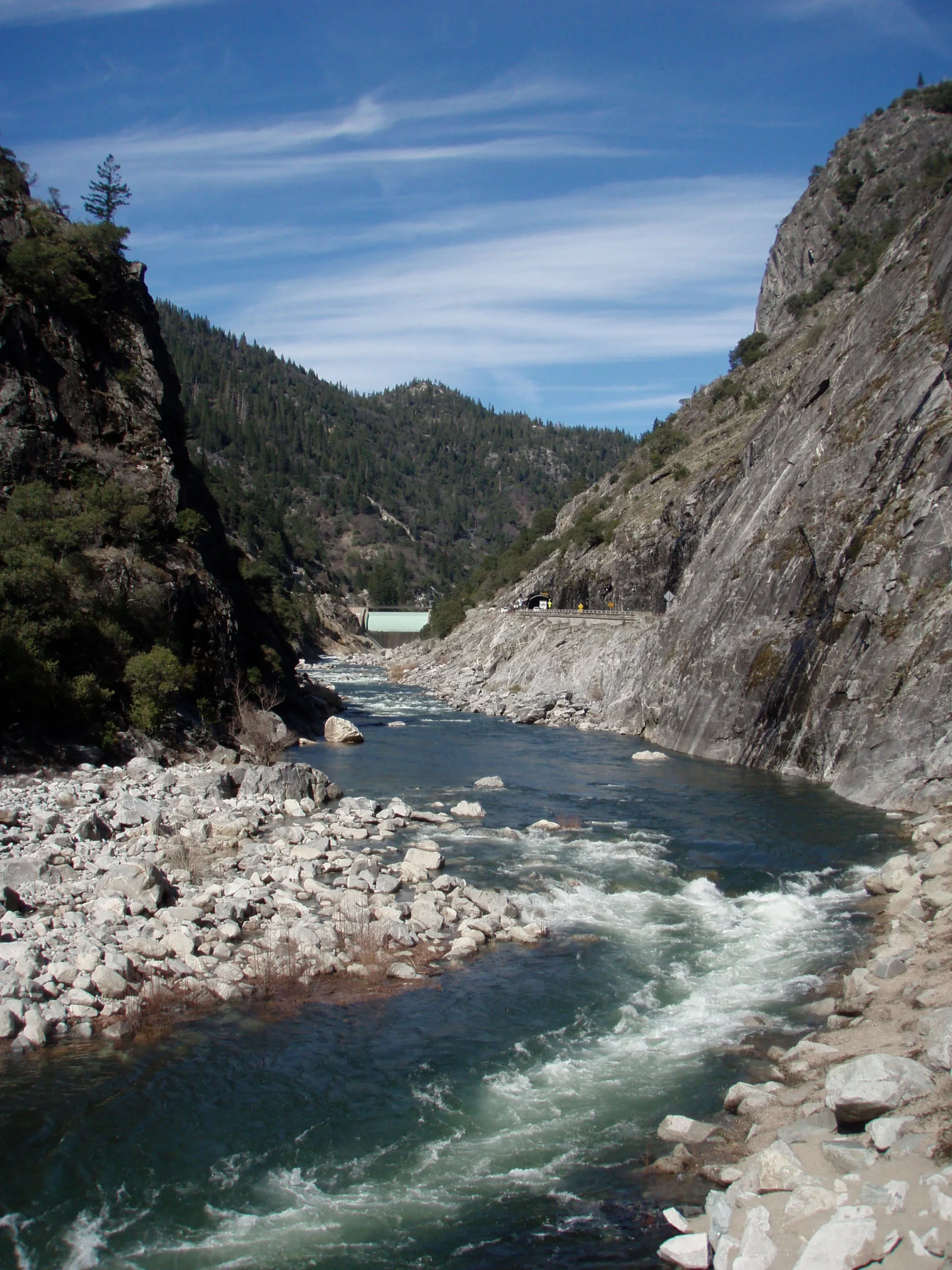PG&E Proposal Impacts 500 Miles of CA Rivers

By Theresa Lorejo-Simsiman
Pacific Gas & Electric (PG&E) operates 22 hydropower projects on 500 river miles across California that American Whitewater has spent nearly 30 years of work to protect and restore. This includes whitewater reaches on the North Fork Feather, the Pit, the McCloud, Butte Creek, Fordyce, the South Yuba, the Bear, the Eel, the Mokelumne, the San Joaquin and the North Fork Kings. Now, in an application before the California Public Utilities Commission (CPUC), PG&E is proposing to transfer all non-nuclear assets including these 22 hydropower projects to a new and separate subsidiary, Pacific Generation LLC (PacGen).
In response, American Whitewater has joined members of the California Hydropower Reform Coalition (CHRC) to make a year-long case before the CPUC to oppose this transaction. It has become clear that this transaction is about protecting PG&E’s shareholders and is not in the public interest. If the CPUC agrees to approve this transaction, there needs to be strict conditions and accountability for public safety, ratepayers, and the protection of our rivers across California.
In other words, American Whitewater believes that the CPUC should not simply rubber stamp the largest, unprecedented, and “first of its kind” handover of hydropower assets. This asset transfer will impact dam safety and the operation and maintenance of multiple projects that restore ecological and recreational releases to our rivers. We need California paddlers to help persuade the CPUC to take heed. Read on to find out how you can help!
BACKGROUND
Scattered throughout California rivers transformed by PG&E hydropower projects are 62 powerhouses, 97 reservoirs, 72 diversions, 167 dams, and 400 miles of water conveyance systems. PG&E proposes to transfer these hydropower assets along with natural gas, solar and battery energy storage projects to a separate subsidiary, PacGen, where PG&E will retain 51% ownership and sell off 49% to Minority Investors who have yet to be identified. PG&E proposes to raise $1.1 to $2.5 billion from this proposed transaction which is a scant amount compared to the total stated capital need of approximately $40 billion to $53 billion for 2022 through 2026.
PacGen will assume all liability and responsibility for the transferred assets. They will have one employee, the President of PacGen, and will be managed by a Board of Managers composed of PG&E officers and potentially one or more Minority Investors. PacGen will then be responsible to contract PG&E as a service provider to provide the same personnel that operate these assets today. PG&E claims, throughout its application and testimony before the CPUC, that this arrangement will not change the operation and maintenance of these assets, but the minority investors of PacGen will retain voting rights that can change dynamics on the ground to maximize their own interests.
THE RUB
Armed with 30 years of “on the ground” knowledge and experience working on a multitude of PG&E hydropower projects, American Whitewater and members of the CHRC are well positioned to bring concerns regarding PG&E’s application to the CPUC. Some of the key concerns outlined in an opening brief put together by Water and Power Law Group PC and filed on our behalf include:
- Public Interest: Asset transfers of this magnitude should prioritize public interest, especially when critical infrastructure and public utilities are involved. Opening briefs from ratepayer advocates at The Utility Reform Network (TURN) and California Community Choice Association highlight the overwhelming benefits for PG&E shareholders at the expense of California ratepayers and the public interest.
- Dam Safety Concerns: Dave Steindorf, American Whitewater Hydropower Specialist, details in his testimony dam safety concerns. PG&E’s aging hydroelectric assets, especially dams, require stringent safety measures, rigorous inspections, and dedicated maintenance. Details on how dam safety would work between the bureaucracy of PG&E and PacGen are noticeably absent from the current application. It is imperative that any transfer of such assets come with clear protocols and frameworks to ensure their continued safety and reliability.
- Environmental Stewardship: California has always been at the forefront of environmental preservation and conservation. It is crucial to ensure that any asset transfer does not compromise our commitment to the environment. The potential impact on our state’s waterways, wildlife, and broader ecosystem needs rigorous examination.
- Investment Incentives: CHRC testimony also highlighted the concern that the proposed transaction might favor investments in operations & maintenance (O&M) and capital improvements for some hydroelectric assets but not others. Projects such as Butte Creek, Battle Creek and Potter Valley on the Eel River, are already seeing failures of canals, dams failure and electric infrastructure that can be made worse as a result of this transaction. A selective approach to O&M could compromise the overall reliability and safety of our hydroelectric infrastructure by deferring maintenance on less attractive hydropower investments.
PG&E ASKS THE CPUC TO DISREGARD OUR RIVER INTERESTS
Our hope during this proceeding was that PG&E would consider our concerns and attempt to address at least some of the issues we raised. Instead, PG&E has taken a completely different tack declaring in their opening brief that the “Commission should disregard CHRC’s arguments, which are outside the scope of this proceeding, and which provide no basis for rejecting or imposing conditions on the Application.” American Whitewater adamantly disagrees. The CPUC has an obligation to protect the public interest ensuring that transferred facilities operate safely, reliably, and consistent with environmental protection. Please join our campaign to prevent the CPUC from rubber stamping PG&E’s application by using the instructions below to provide public comments – our whitewater rivers deserve your efforts!.
HOW TO PROVIDE PUBLIC COMMENTS TO THE CPUC
- Go to the following California Public Utilities Commission Docket link: https://apps.cpuc.ca.gov/apex/f?p=401:1:0
- Enter A2209018 in the box next to the Proceeding Number Search and click the Search button.
- Click on the blue A2209018 ACTIVE link under the heading Proceeding Number.
- Click the Public Comments tab at the top of this page
- On the “A2209018 – Public Comments” page click the Add Public Comment button in the middle of the page and click OK to the Public Records Acts Disclaimer. Then copy and paste the sample comments provided below into the comment field or make your own comments as a PG&E Ratepayer, a member of the public, or a stakeholder who would be impacted by the proposed asset transfer. Fill in your name, city, state, zip code, email & phone number. Verify you are not a robot and hit submit.
SAMPLE COMMENT IN OPPOSITION TO PG&E’s PROPOSED ASSET TRANSFER
Dear Honorable Members of the California Public Utilities Commission,
I am writing to express strong opposition to PG&E’s current application to transfer its non-nuclear assets, including 22 pivotal hydropower projects, to Pacific Generation LLC (PacGen). The CPUC has an enduring responsibility to protect the public interest, particularly when ensuring that PG&E’s transferred facilities operate safely, reliably, and in line with environmental protection principles. I urge the CPUC to stand with Californians who believe that this asset transfer is not in the public’s best interest. A decision of this magnitude should not be rubber-stamped without due diligence and thorough consideration of its widespread implications. Here are my key concerns:
- PUBLIC INTEREST: It is of paramount importance that the CPUC ensures any asset transfers prioritize the public interest. The overwhelming evidence suggests this transaction significantly benefits PG&E shareholders while sidestepping the needs and concerns of California ratepayers.
- DAM SAFETY: PG&E’s application falls short in addressing crucial dam safety concerns. With an aging infrastructure that plays a pivotal role in our state’s energy supply, a clear, stringent protocol for ensuring dam safety is non-negotiable.
- ENVIRONMENTAL STEWARDSHIP: The proposed transfer puts at risk California’s longstanding commitment to environmental protection. Without rigorous examination, there’s potential for irreversible harm to our state’s ecosystems.
- INVESTMENT INCENTIVES: The potential for selective investment in certain hydroelectric assets and not others poses a direct threat to the reliability and safety of our hydroelectric infrastructure.
This post originally appeared at americanwhitewater.org.


